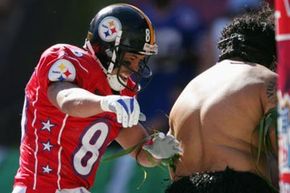History of the NFL Pro Bowl
The idea of a pro football all-star game predates the league's presence on television, going back to 1939, when the NFL Champion New York Giants defeated the Pro All-Stars 13-10 at Los Angeles' Wrigley Field [source: Pro Football Hall of Fame]. These all-star games would continue until 1942, before a hiatus that lasted until the 1950 season [source: Fletcher].
In January 1951, the Pro Bowl was revived with a new format -- bringing together the most outstanding players at each position to play what amounts to a competitive scrimmage --as the American Conference edged the National Conference 28-27 at the Los Angeles Memorial Coliseum -- the event's new home for the next two decades.
Advertisement
Between 1972 and 1980, the game bounced around host cities before being moved to Hawaii in 1980. This became the home of the Pro Bowl until 2009, when the game was moved to the mainland and played the week before the Super Bowl.
When the game, officially called the AFC-NFC Pro Bowl, moved to Aloha Stadium in Honolulu, Hawaii, in 1980, the cachet and value of being selected to play automatically increased. It was the last bit of football before the long offseason and Pro Bowlers looked forward to the free trip to Hawaii and a chance to celebrate the end of the grueling campaign. The game itself took on a more relaxed tone, with very little time spent on game planning or other aspects of the intense preparation that goes into a typical regular-season or playoff game.
In fact, there are special rules that apply to the game to prevent injuries. For example, on offense, the quarterback can throw the ball away at any time to avoid being sacked without risking an intentional-grounding penalty. And on defense, blitzes are off limits and only linemen can rush the quarterback. This softer style of play is less interesting to the casual fan, and since most NFL rivalries are within divisions, there is little satisfaction watching your beloved QB share snaps with his archrival.
